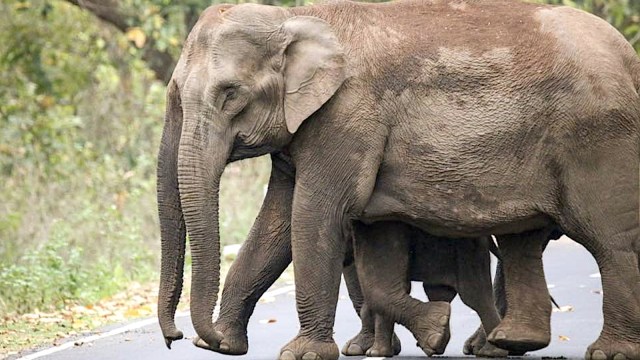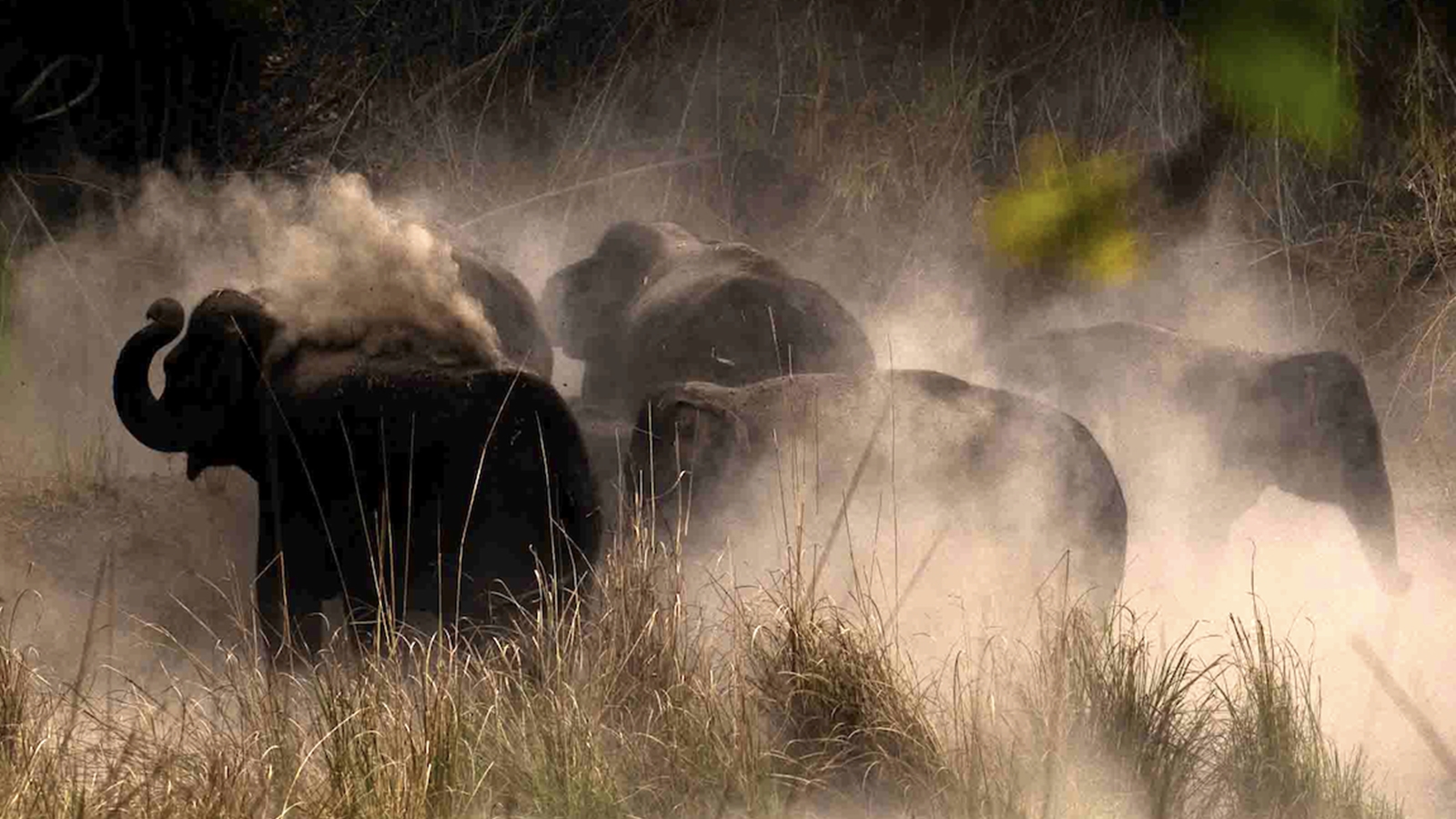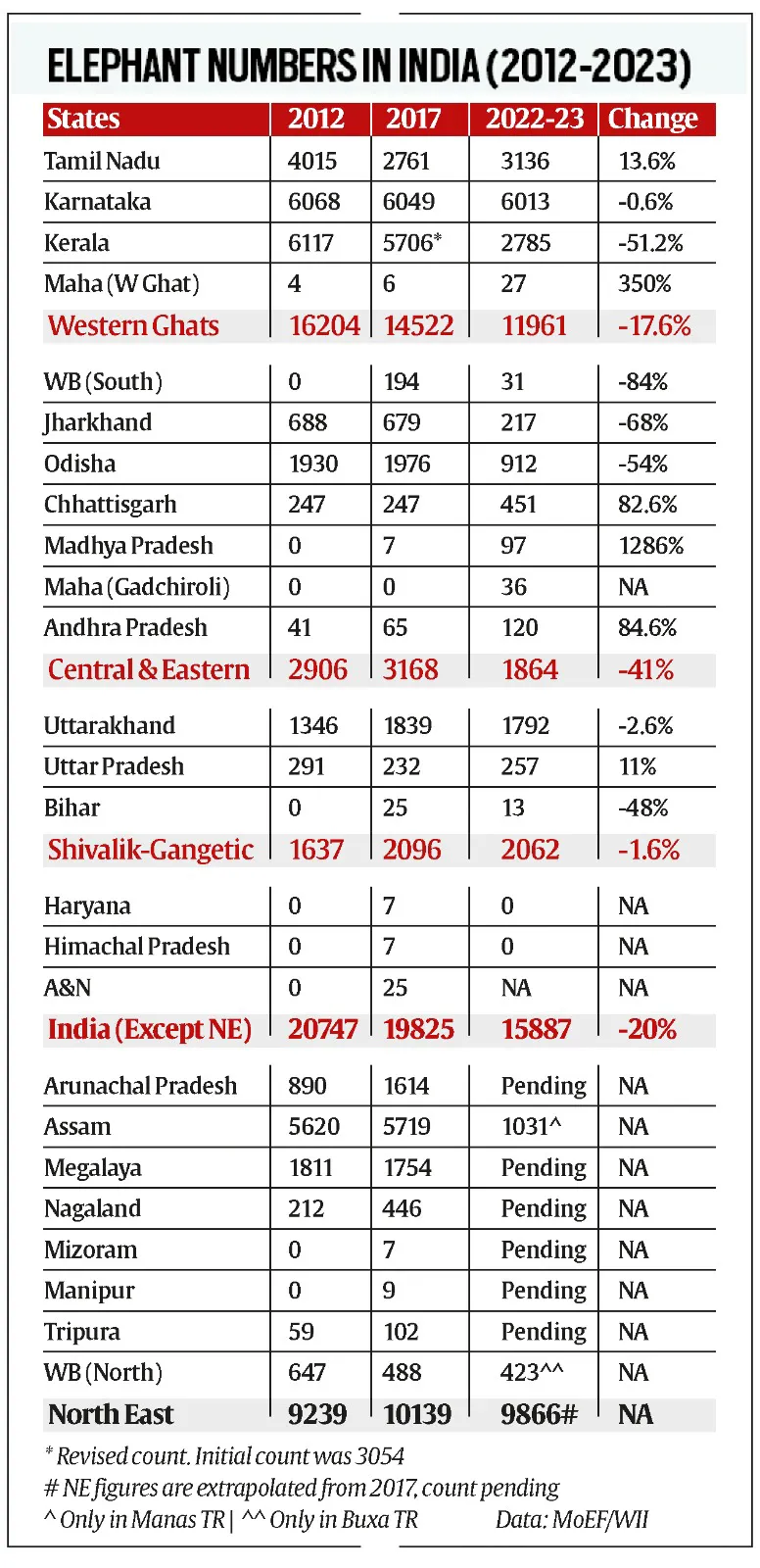Hundreds of copies of the Environment Ministry’s elephant census report — Status of Elephant in India 2022-23 — have been gathering dust since February this year. The government hasn’t released the report citing a delay in the census in the Northeast.

Besides recording the dip in the elephant numbers, the unreleased report identifies “mushrooming developmental projects” such as “unmitigated mining and linear infrastructure construction” as significant threats to the species.
When contacted, the ministry said this is an interim report. The final report, including the estimation of elephants in the northeast, is expected by the end of June 2025, it said.
 Elephants from Orissa reached the Bandhavgarh tiger reserve in Madhya Pradesh in 2018. The 2022-23 report says that “unmitigated mining and linear infrastructure construction” have pushed elephants to venture into historical but currently unoccupied areas, fuelling human-elephant conflicts. (Photo: Vikram Singh)
Elephants from Orissa reached the Bandhavgarh tiger reserve in Madhya Pradesh in 2018. The 2022-23 report says that “unmitigated mining and linear infrastructure construction” have pushed elephants to venture into historical but currently unoccupied areas, fuelling human-elephant conflicts. (Photo: Vikram Singh)
The elephant census is conducted every five years by the Wildlife Institute of India (WII), an autonomous body under the ministry. The unreleased report, authored by seven scientists and officials of the Dehradun-based WII and its nodal ministry in New Delhi, is the first-ever “scientific” estimate of India’s elephant population.
In the Central Indian and Eastern Ghats cluster which saw the biggest slide in elephant population, Southern West Bengal, Jharkhand and Orissa saw the maximum loss — 84 per cent, 68 per cent and 54 per cent, respectively. These three regions saw a drop of nearly 1,700 elephants, of which up to 400 could have moved to other states in the landscape such as Chhattisgarh, Madhya Pradesh and Andhra Pradesh.
 When contacted, the ministry said this is an interim report. The final report, including the estimation of elephants in the northeast, is expected by the end of June 2025, it said.
When contacted, the ministry said this is an interim report. The final report, including the estimation of elephants in the northeast, is expected by the end of June 2025, it said.
The drop in the Western Ghats landscape could be as high as 18 per cent, primarily due to a slide in the elephant population of Kerala by nearly 2,900 (51 per cent) from the revised estimate of 2017. Only the northern population of Shivalik hills and Gangetic plains appeared stable with a marginal 2 per cent drop.
Story continues below this ad
Due to “extremely limited” primary data that delayed the modelling of elephant density in the Northeastern states, the report’s figures for the Northeast are extrapolated from the previous count in 2017, when the region’s 10,139 elephants accounted for a third of the country’s overall elephant population of 29,964.
“Since there was no deadline in sight for the Northeast and because we were already late for the five-year cycle, it was decided to publish the report for the rest of India and later add a volume for the Northeast. But there was a change of plan at the last minute. Formally, we have been told to wait for the Northeast data,” said a wildlife scientist working with the project.
The Indian Express reached out to Environment Minister Bhupender Yadav on why the report, printed in February, was not released. In response, the ministry said in a statement, “An interim draft report was prepared by WII. However, it did not have a uniform methodology and results, especially for the Northeastern states… (where) the estimation… is expected to be completed by WII next year and a report is expected by the end of June 2025. The process involves new methods including DNA profiling and camera traps which was not done by WII in the Northeast region due to paucity of time and required training and other logistics.”
On the significant drop in the elephant numbers in the east-central and southern landscapes, the ministry said: “This is an ongoing exercise and the progress of the same is being reviewed regularly in the Ministry at various levels. The ongoing exercise uses a framework that is used for the monitoring of Tigers, co-predators and prey… (which) is different from the All India Synchronized Elephant Population Estimation 2017.
Story continues below this ad
Celebrating Elephant Day on August 12, Minister Yadav had tweeted: “The elephant population in India continues to be stable.”
While Ramesh Pandey, director of Project Elephant and one of the seven authors of the unreleased report, said he was away on training, WII’s Qamar Qureshi, the lead author, and his co-author WII director Virendra Tiwari did not respond to requests for comments.
Claiming that even the Northeast population will undergo “a rationalisation by 20-25%” when modelled properly, a senior elephant researcher described as “illogical” the ministry’s “reluctance” to accept the numbers for the rest of India, which, he said, should not be compared with the figures thrown up by past counts.
“Until 2017, we relied on either direct (head) count or indirect (dung) count of elephants. This time, we are attempting statistical modelling based on mark-recapture, as we have already done for tigers and leopards, to get reliable baseline data for elephants. So the gap in numbers doesn’t necessarily mean we lost that many elephants in just four to five years. It’s a reality check that elephants have not been doing well for quite some time,” he explained.
Story continues below this ad
The report urged future strategies to be aligned with the goals of strengthening corridors and connectivity, restoring habitat, enhancing protection, mitigating developmental projects, and ensuring the support of local communities for elephant conservation.
Specifically, the report highlighted the fragmentation of the east-central landscape by “unmitigated mining and linear infrastructure construction” which “has prompted long-ranging elephants to venture into historical range, but currently unoccupied areas,” fuelling human-elephant conflicts. Poaching, railway collisions, and electrocution by power lines are the other threats identified in this landscape.
The report also warned that the once-contiguous elephant population in the Western Ghats — southern Maharashtra to Kerala — is “rapidly disconnecting due to changing land use, including expanding commercial plantations (coffee and tea), farmland fencing, human encroachment and mushrooming developmental projects.”
Even the relatively stable Shivalik-Terai population in Uttarakhand and Uttar Pradesh, the report noted, “confronts significant threats… from encroachments, forest clearing, monoculture, and invasive species” as well as intensified agriculture and linear infrastructure.
Story continues below this ad
In the Northeast, the report found that the elephant populations are scattered in a mosaic dominated by human habitations, tea plantations, mines, oil refineries and linear infrastructure, making their movements and lives precarious. The report also identified poaching for ivory as a major threat in this landscape.
Hinting at the absence of robust data in the Northeast, the report called for a “focused estimation exercise… to comprehensively assess occupancy and abundance to devise specific conservation actions.”
A wildlife scientist based in Assam pointed out that the elephant faces major challenges outside “a few islands” of safety. “Often, these pockets are tiger reserves. Kaziranga and now Manas, for example, in Assam. Nagarhole and Bandipur in Karnataka, or Corbett in Uttarakhand. But such pockets cannot sustain a species that roam long distances,” he said.



 Elephants from Orissa reached the Bandhavgarh tiger reserve in Madhya Pradesh in 2018. The 2022-23 report says that “unmitigated mining and linear infrastructure construction” have pushed elephants to venture into historical but currently unoccupied areas, fuelling human-elephant conflicts. (Photo: Vikram Singh)
Elephants from Orissa reached the Bandhavgarh tiger reserve in Madhya Pradesh in 2018. The 2022-23 report says that “unmitigated mining and linear infrastructure construction” have pushed elephants to venture into historical but currently unoccupied areas, fuelling human-elephant conflicts. (Photo: Vikram Singh) When contacted, the ministry said this is an interim report. The final report, including the estimation of elephants in the northeast, is expected by the end of June 2025, it said.
When contacted, the ministry said this is an interim report. The final report, including the estimation of elephants in the northeast, is expected by the end of June 2025, it said.





























